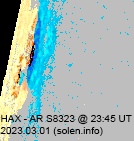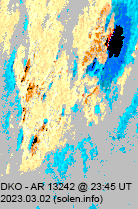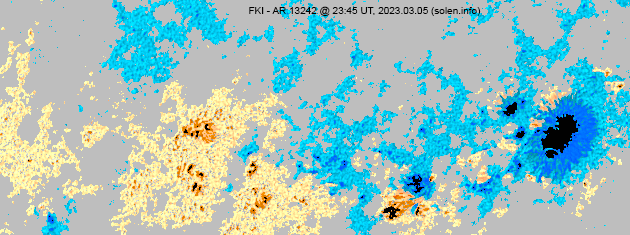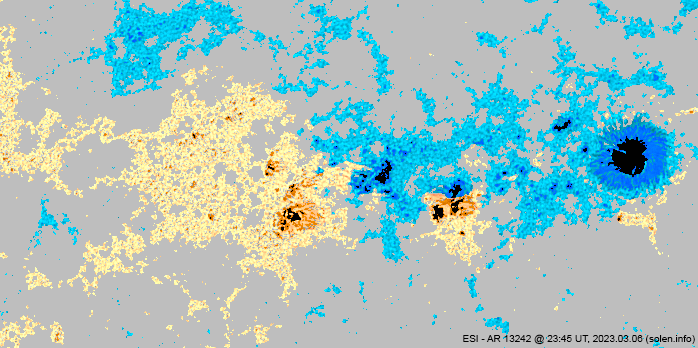13242
N10E66 Data 2023-03-01
Long Jupiter 77 area 10
 New region 13242 [N10E66] 10 rotated partly into view on March 1 as S8323 [N11E81]
New region 13242 [N10E66] 10 rotated partly into view on March 1 as S8323 [N11E81]report(past month only)
13242
N10E66 Data 2023-03-02
Long Jupiter 78 area 10
 New region 13242 [N10E66] 10 rotated partly into view on March 1 and was numbered the next day by SWPC as the region developed slowly.
New region 13242 [N10E66] 10 rotated partly into view on March 1 and was numbered the next day by SWPC as the region developed slowly.report(past month only)
13242
N10E53 Data 2023-03-03
Long Jupiter 91 area 140
 Region 13242 [N10E53] 140 developed slowly and quietly.
Region 13242 [N10E53] 140 developed slowly and quietly.report(past month only)
13242
N10E38 Data 2023-03-04
Long Jupiter 108 area 140
 Region 13242 [N10E38] 140 developed slowly and could produce M class flares.
Region 13242 [N10E38] 140 developed slowly and could produce M class flares.report(past month only)
13242
N10E24 Data 2023-03-05
Long Jupiter 123 area 170
 Region 13242 [N10E24] 170 developed further and has a magnetic delta in an intermediate spot section. A major flare is possible.
Region 13242 [N10E24] 170 developed further and has a magnetic delta in an intermediate spot section. A major flare is possible.report(past month only)
13242
N09E11 Data 2023-03-06
Long Jupiter 136 area 240
 Region 13242 [N09E11] 240 still has a magnetic delta in an intermediate spot section. The leader spot became symmetrical and lost area. A major flare is possible.
Region 13242 [N09E11] 240 still has a magnetic delta in an intermediate spot section. The leader spot became symmetrical and lost area. A major flare is possible.report(past month only)
13242
N10W17 Data 2023-03-08
Long Jupiter 167 area 245
 Region 13242 [N10W17] 245 lost the magnetic delta. Minor polarity intermixing still exists and another M class flare is possible.
Region 13242 [N10W17] 245 lost the magnetic delta. Minor polarity intermixing still exists and another M class flare is possible.report(past month only)
13242
N10W32 Data 2023-03-09
Long Jupiter -178 area 170
 Region 13242 [N10W32] 170 decayed quickly and produced a few C flares. C1 flares: C1.4 @ 06:31 UT
Region 13242 [N10W32] 170 decayed quickly and produced a few C flares. C1 flares: C1.4 @ 06:31 UTreport(past month only)
13242
N10W48 Data 2023-03-10
Long Jupiter -162 area 110
 Region 13242 [N10W48] 110 decayed quickly and was mostly quiet. C1 flares: C1.6 @ 11:32 UT
Region 13242 [N10W48] 110 decayed quickly and was mostly quiet. C1 flares: C1.6 @ 11:32 UTreport(past month only)
13242
N11W61 Data 2023-03-11
Long Jupiter -148 area 100
 Region 13242 [N11W61] 100 decayed slowly and quietly.
Region 13242 [N11W61] 100 decayed slowly and quietly.report(past month only)
13242
N11W75 Data 2023-03-12
Long Jupiter -133 area 100
 Region 13242 [N11W75] 100 decayed slowly and quietly.
Region 13242 [N11W75] 100 decayed slowly and quietly.report(past month only)